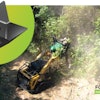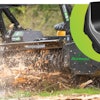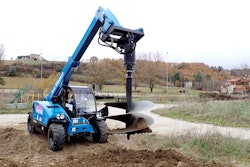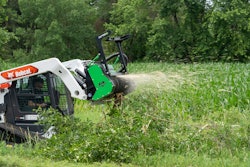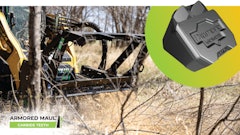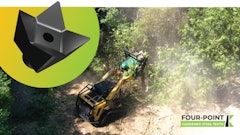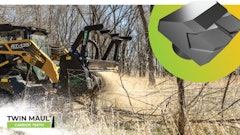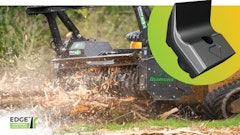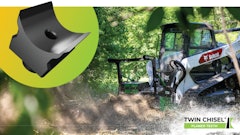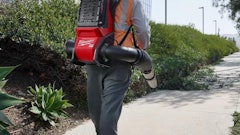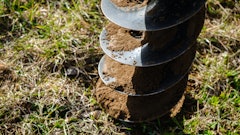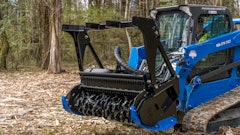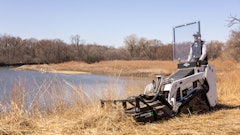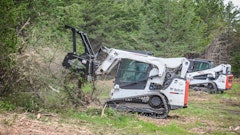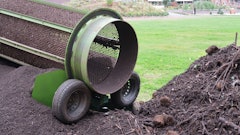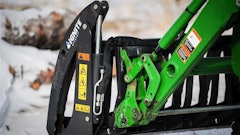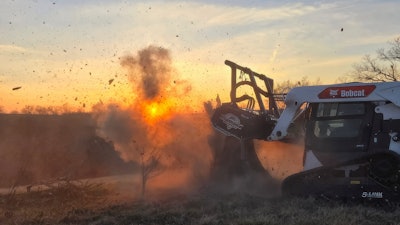
For customers with upcoming work that could include land clearing, vegetation management, or utility/roadside maintenance, a drum mulcher can be an essential tool. But which drum is best for your rental customer’s particular needs? Each type of drum mulcher is tailored for different functions and comes with its own advantages.
To assist in the selection process, the following is an overview of model differences, features, and benefits to better solve your customer’s problems with the right solution. 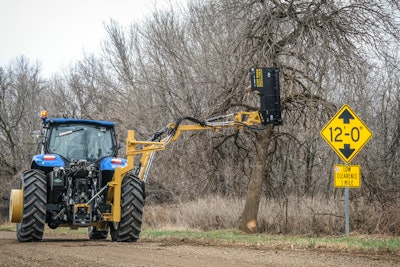 Diamond has three depth controls mulchers that are compatible with most skid-steers, excavators and CTLs to add versatility and productivity to customers’ existing assets. The Skid-Steer DC Pro is compatible with ASV, Bobcat, Caterpillar, JCB, John Deere, Kubota, New Holland and Takeuchi brands. The Skid-Steer DC Pro X is compatible with ASV, Bobcat, Caterpillar, Gehl, John Deere and Kubota brands. The Excavator DC Pro X is compatible with ASV, Bobcat, Caterpillar, Gehl, John Deere and Kubota brands. On the other hand, Diamond’s open drum mulcher (Skid-Steer OD Pro X) is open-compatible with most skid-steer brands, including ASV, Bobcat, Caterpillar, Gehl, John Deere and Kubota brands.Diamond Mowers
Diamond has three depth controls mulchers that are compatible with most skid-steers, excavators and CTLs to add versatility and productivity to customers’ existing assets. The Skid-Steer DC Pro is compatible with ASV, Bobcat, Caterpillar, JCB, John Deere, Kubota, New Holland and Takeuchi brands. The Skid-Steer DC Pro X is compatible with ASV, Bobcat, Caterpillar, Gehl, John Deere and Kubota brands. The Excavator DC Pro X is compatible with ASV, Bobcat, Caterpillar, Gehl, John Deere and Kubota brands. On the other hand, Diamond’s open drum mulcher (Skid-Steer OD Pro X) is open-compatible with most skid-steer brands, including ASV, Bobcat, Caterpillar, Gehl, John Deere and Kubota brands.Diamond Mowers
Depth Control vs. Open Drum
There are two common types of drum mulcher attachments – depth control (DC) and open drum (OD). Understanding the functions, features, and intended applications of each will help you determine the best attachment your customer will need. Both options come in varying widths for tackling different-sized jobs.
Cutting (or working) widths can range from 28-72 in. to efficiently process trees, brush, and undergrowth up to 9 in. in diameter. Additionally, both styles of mulchers attach to most skid-steer brands and are compatible with different types of mulching teeth, allowing users to interchange them for various applications.
The key differences between depth control and open drum mulchers lie in their operation and applications. For instance, Diamond’s open drum model works in unison with carbide teeth, excels in applications involving heavy ground engagement, and is at its best when mulching smaller material into a slightly larger, stringier end product.
Conversely, depth-control mulchers are optimized for sharp steel teeth and shine in high-production environments with limited ground engagement. These mulchers are more appropriate for users who take down larger materials and prefer a fine, aesthetically pleasing mulch.
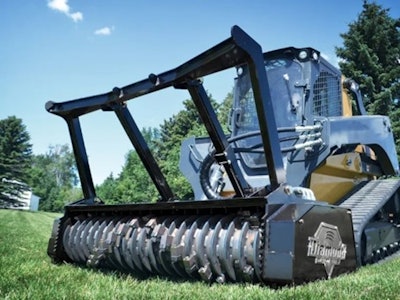 Diamond depth control mulchers can accommodate most standard and high-flow carriers with flow ratings between 12-40 GPM (EX DC Pro X), 16-30 GPM (SS DC Pro) and 23-50 GPM (SS DC Pro X). Our open drum mulcher accommodates most standard and high-flow carriers with flow ratings between 16-46 GPM.Diamond Mowers
Diamond depth control mulchers can accommodate most standard and high-flow carriers with flow ratings between 12-40 GPM (EX DC Pro X), 16-30 GPM (SS DC Pro) and 23-50 GPM (SS DC Pro X). Our open drum mulcher accommodates most standard and high-flow carriers with flow ratings between 16-46 GPM.Diamond Mowers
Depth Control
Especially productive when processing large-diameter material, a depth-control mulcher features a closed-throat design and sharp steel teeth that push trees and brush onto the rotor. The teeth then cut and reduce the size of the material before it enters the processing chamber. Its helical tooth pattern is modeled after a vacuum brush to feed material efficiently toward the drum's center, while depth control rings limit bite size for optimal infeed.
Primarily employed in large-scale brush clearing, undergrowth removal, and vegetation management projects with limited ground contact, depth control mulchers excel at removing trees and larger material with speed. Due to their sharp teeth, they are particularly effective for processing hard or fibrous wood, such as bamboo or palm, making them more efficient than open drum models. By limiting the bite-size, they produce a finer mulch, making them ideal for tasks where aesthetics are important.
Applications best tackled with a DC mulcher:
- Reclamation projects such as land clearing, fence line and shooting lane maintenance, pasture management, and trail creation
- Infrastructure development like mulching, brush clearing, and processing unwanted vegetation
- Creating defensible space by removing brush and trees near homes and structures – removing these fuels to act as a barrier and reduce the spread and intensity of fires
- Municipal tasks like roadside maintenance for accessibility and safety for both rural and gravel roads, major highways, ponds, or utility systems.
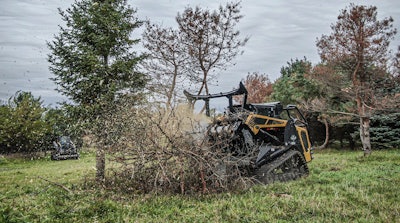 The OD Pro X’s larger opening, designed to pull in whole tree limbs, makes it highly effective for quick brush and undergrowth removal.Diamond Mowers
The OD Pro X’s larger opening, designed to pull in whole tree limbs, makes it highly effective for quick brush and undergrowth removal.Diamond Mowers
Open Drum
Designed for a variety of heavy-duty mulching tasks, open drum mulchers are ideal for clearing land for agricultural use, infrastructure development, and habitat restoration projects. By engaging with more of the cutting tooth, this type of mulcher offers a larger bite size and maximum productivity, making it well-suited for applications involving smaller material and significant ground engagement. Additionally, its carbide teeth make it perfect for handling rough, rocky terrain.
Applications best tackled with an OD mulcher: 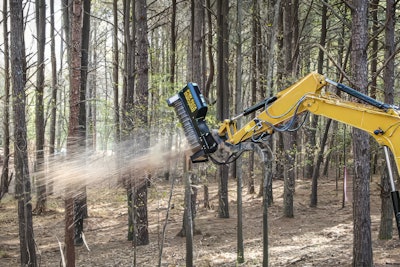 The Excavator DC Pro X is engineered to tackle mulching and brush-clearing tasks with power and precision, effectively cutting back and processing unwanted vegetation.Diamond Mowers
The Excavator DC Pro X is engineered to tackle mulching and brush-clearing tasks with power and precision, effectively cutting back and processing unwanted vegetation.Diamond Mowers
- Storm/ Disaster Cleanup, Fire Prevention, and Recovery Efforts – the large opening of an OD mulcher is designed to pull in whole tree limbs, which is highly effective for quick brush and undergrowth removal
- Pasture Maintenance - the post-harvest period presents an ideal opportunity to clear trees and brush surrounding agricultural fields in preparation for the next growing season. Regular mowing of pastures offers several benefits, including enhancing forage quality, ensuring a uniform pasture, preventing weed growth, and minimizing grazing patterns. Utilizing an OD mulcher for these tasks would enable customers to effectively control weeds and maintain grass in a vegetative or growing state, thereby increasing its digestibility for livestock.
- Managing Invasive Species - Invasive tree species, such as the Eastern red cedar, can cause extensive damage to properties, whether they're farms, ranches, or forest preserves. These resilient trees can dominate large land areas, depriving native plants and wildlife of essential resources and posing a significant threat to the ecosystem. Mulching provides a more environmentally friendly alternative to herbicides and prescribed burns. The OD mulchers’ carbide teeth will help customers mulch these trees down to smaller pieces, inhibiting their growth and spread and helping control their propagation. The attachment’s maneuverability enables precision and selectivity so operators can target these intruders while sparing native grasses and plants. By suppressing invasive species' resurgence and promoting desirable vegetation growth, an open drum can be a valuable ally in facilitating weed suppression, erosion control, and biodiversity enhancement.
- Right-of-Way Maintenance - An OD mulcher excels in right-of-way maintenance, particularly for clearing tree limbs and overgrowth around roadways and powerlines. Since these areas are regularly maintained, vegetation growth is typically not extensive, and aesthetics are not a primary concern. Therefore, an OD mulcher is often preferred for such tasks.
When selecting the right drum mulcher for your rental fleet, consider your customer’s specific requirements in terms of power, cutting capacity, and mulch size requirements. Consulting with your equipment dealer can also provide valuable insights into selecting the best attachment(s) to add to your fleet by comparing what applications and job types are in your area.


